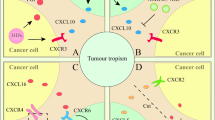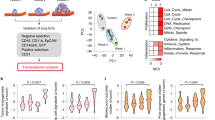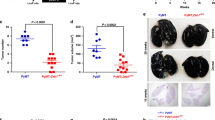Abstract
Interactions between cancer cells and stromal cells, including blood vessel endothelial cells (BECs), lymphatic vessel endothelial cells (LECs), bone marrow-derived angiogenic cells (BMDACs) and other bone marrow-derived cells (BMDCs) play important roles in cancer progression. Intratumoral hypoxia, which affects both cancer and stromal cells, is associated with a significantly increased risk of metastasis and mortality in many human cancers. Recent studies have begun to delineate the molecular mechanisms underlying the effect of intratumoral hypoxia on cancer progression. Reduced O2 availability induces the activity of hypoxia-inducible factors (HIFs), which activate the transcription of target genes encoding proteins that play important roles in many critical aspects of cancer biology. Included among these are secreted factors, including angiopoietin 2, angiopoietin-like 4, placental growth factor, platelet-derived growth factor B, stem cell factor (kit ligand), stromal-derived factor 1, and vascular endothelial growth factor. These factors are produced by hypoxic cancer cells and directly mediate functional interactions with BECs, LECs, BMDACs and other BMDCs that promote angiogenesis, lymphangiogenesis, and metastasis. In addition, lysyl oxidase (LOX) and LOX-like proteins, which are secreted by hypoxic breast cancer cells, remodel extracellular matrix in the lungs, which leads to BMDC recruitment and metastatic niche formation.
This is a preview of subscription content, access via your institution
Access options
Subscribe to this journal
Receive 50 print issues and online access
$259.00 per year
only $5.18 per issue
Buy this article
- Purchase on Springer Link
- Instant access to full article PDF
Prices may be subject to local taxes which are calculated during checkout


Similar content being viewed by others
References
Bissell MJ, Hines WC . Why don't we get more cancer? A proposed role of the microenvironment in restraining cancer progression. Nat Med 2011; 17: 320–329.
Polyak K, Kalluri R . The role of the microenvironment in mammary gland development and cancer. Cold Spring Harb Perspect Biol 2010; 2: a003244.
Hanahan D, Coussens LM . Accessories to the crime: functions of cells recruited to the tumor microenvironment. Cancer Cell 2012; 21: 309–322.
Höckel M, Schlenger K, Aral B, Mitze M, Schäfer U, Vaupel P . Association between tumor hypoxia and malignant progression in advanced cancer of the uterine cervix. Cancer Res 1996; 56: 4509–4515.
Brizel DM, Scully SP, Harrelson JM, Layfield LJ, Bean JM, Prosnitz LR et al. Tumor oxygenation predicts the likelihood of distant metastases in human soft tissue sarcoma. Cancer Res 1996; 56: 941–943.
Wang GL, Semenza GL . Purification and characterization of hypoxia-inducible factor 1. J Biol Chem 1995; 270: 1230–1237.
Wang GL, Jiang BH, Rue EA, Semenza GL . Hypoxia-inducible factor 1 is a basic-helix-loop-helix-PAS heterodimer regulated by cellular O2 tension. Proc Natl Acad Sci USA 1995; 92: 5510–5514.
Manalo DJ, Rowan A, Lavoie T, Natarajan L, Kelly BD, Ye SQ et al. Transcriptional regulation of vascular endothelial cell responses to hypoxia by HIF-1. Blood 2005; 105: 659–669.
Mole DR, Blancher C, Copley RR, Pollard PJ, Gleadle JM, Ragoussis J et al. Genome-wide association of hypoxia-inducible factor (HIF)-1α and HIF-2α DNA binding with expression profiling of hypoxia-inducible transcripts. J Biol Chem 2009; 284: 16767–16775.
Semenza GL . Defining the role of hypoxia-inducible factor 1 in cancer biology and therapeutics. Oncogene 2010; 29: 625–634.
Vaupel P, Mayer A, Höckel M . Tumor hypoxia and malignant progression. Meth Enzymol 2004; 381: 335–354.
Bos R, van der Groep P, Greijer AE, Shvarts A, Meijer S, Pinedo HM et al. Levels of hypoxia-inducible factor-1α independently predict prognosis in patients with lymph node negative breast carcinoma. Cancer 2003; 97: 1573–1581.
Dales JP, Garcia S, Meunier-Carpentier S, Andrac-Meyer L, Haddad O, Lavaut MN et al. Overexpression of hypoxia-inducible factor HIF-1α predicts early relapse in breast cancer: retrospective study in a series of 745 patients. Int J Cancer 2005; 116: 734–739.
Vergis R, Corbishley CM, Norman AR, Bartlett J, Jhavar S, Borre M et al. Intrinsic markers of tumor hypoxia and angiogenesis in localised prostate cancer and outcome of radical treatment: a retrospective analysis of two randomised radiotherapy trials and one surgical cohort study. Lancet Oncol 2008; 9: 342–351.
Tian H, McKnight SL, Russell DW . Endothelial PAS domain protein 1 (EPAS1), a transcription factor selectively expressed in endothelial cells. Genes Dev 1997; 11: 72–82.
Löfstedt T, Fredlund E, Holmquist-Mengelbier L, Pietras A, Ovenberger M, Poellinger L et al. Hypoxia-inducible factor 2α in cancer. Cell Cycle 2007; 6: 919–926.
Zhang H, Wong CC, Wei H, Gilkes DM, Korangath P, Chaturvedi P et al. HIF-1-dependent expression of angiopoietin-like 4 and L1CAM mediates vascular metastasis of hypoxic breast cancer cells to the lungs. Oncogene 2012; 31: 1757–1770.
Wong CC, Gilkes DM, Zhang H, Chen J, Wei H, Chaturvedi P et al. Hypoxia-inducible factor 1 is a master regulator of breast cancer metastatic niche formation. Proc Natl Acad Sci USA 2011; 108: 16369–16374.
Imamura T, Kikuchi H, Herraiz MT, Park DY, Mizukami Y, Mino-Kenduson M et al. HIF-1α and HIF-2α have divergent roles in colon cancer. Int J Cancer 2009; 124: 763–771.
Lee K, Zhang H, Qian DZ, Rey S, Liu JO, Semenza GL . Acriflavine inhibits HIF-1 dimerization, tumor growth, and vascularization. Proc Natl Acad Sci USA 2009; 106: 17910–17915.
Wong CC, Zhang H, Gilkes DM, Chen J, Wei H, Chaturvedi P et al. Inhibitors of hypoxia-inducible factor 1 block breast cancer metastatic niche formation and lung metastasis. J Mol Med (Berl) 2012; 90: 803–815.
Luwor RB, Lu Y, Li X, Mendelsohn J, Fan Z . The antiepidermal growth factor receptor monoclonal antibody cetuximab/C225 reduces hypoxia-inducible factor-1α, leading to transcriptional inhibition of vascular endothelial growth factor expression. Oncogene 2005; 24: 4433–4441.
Zhang H, Qian DZ, Tan YS, Lee K, Gao P, Ren YR et al. Digoxin and other cardiac glycosides inhibit HIF-1α synthesis and block tumor growth. Proc Natl Acad Sci USA 2008; 105: 19579–19586.
Lee K, Qian DZ, Rey S, Wei H, Liu JO, Semenza GL . Anthracycline chemotherapy inhibits HIF-1 transcriptional activity and tumor-induced mobilization of circulating angiogenic cells. Proc Natl Acad Sci USA 2009; 106: 2353–2358.
Isaacs JS, Jung YJ, Mimnaugh EG, Martinez A, Cuttitta F, Neckers LM . Hsp90 regulates a von Hippel Lindau-independent hypoxia-inducible factor-1α-degradative pathway. J Biol Chem 2002; 277: 29936–29944.
Liu YV, Baek JH, Zhang H, Diez R, Cole RN, Semenza GL . RACK1 competes with HSP90 for binding to HIF-1α and is required for O2-independent and HSP90 inhibitor-induced degradation of HIF-1α. Mol Cell 2007; 25: 207–217.
Qian DZ, Kachhap SK, Collis SJ, Verheul HM, Carducci MA, Atadja P et al. Class II histone deacetylases are associated with VHL-independent regulation of hypoxia-inducible factor 1α. Cancer Res 2006; 66: 8814–8821.
Laughner E, Taghavi P, Chiles K, Mahon PC, Semenza GL . HER2 (neu) signaling increases the rate of hypoxia-inducible factor 1α (HIF-1α) synthesis: novel mechanism for HIF-1-mediated vascular endothelial growth factor expression. Mol Cell Biol 2001; 21: 3995–4004.
Liu M, Howes A, Lesperance J, Stallcup WB, Hauser CA, Kadoya K et al. Antitumor activity of rapamycin in a transgenic mouse model of ErbB2-dependent human breast cancer. Cancer Res 2005; 65: 5325–5336.
Thomas GV, Tran C, Mellinghoff IK, Welsbie DS, Chan E, Fueger B et al. Hypoxia-inducible factor determines sensitivity to inhibitors of mTOR in kidney cancer. Nat Med 2006; 12: 122–127.
Chintala S, Najrana T, Toth K, Cao S, Durrani FA, Pili R et al. Prolyl hydroxylase 2 dependent and von Hippel-Lindau independent degradation of hypoxia-inducible factor 1 and 2 α by selenium in clear cell renal cell carcinoma leads to tumor growth inhibition. BMC Cancer 2012; 12: 293.
Rapisarda A, Uranchimeg B, Scudiero DA, Selby M, Sausville EA, Shoemaker RH et al. Identification of small molecule inhibitors of hypoxia-inducible factor 1 transcriptional activation pathway. Cancer Res 2002; 62: 4316–4324.
Takano S, Kamiyama H, Mashiko R, Osuka S, Ishikawa E, Matsumura A . Metronomic treatment of malignant glioma xenografts with irinotecan (CPT-11) inhibits angiogenesis and tumor growth. J Neurooncol 2010; 99: 177–185.
Kummar S, Raffeld M, Juwara L, Horneffer Y, Strassberger A, Allen D et al. Multihistology, target-driven pilot trial of oral topotecan as an inhibitor of hypoxia-inducible factor-1α in advanced solid tumors. Clin Cancer Res 2011; 17: 5123–5131.
Semenza GL . Hypoxia-inducible factors: mediators of cancer progression and targets for cancer therapy. Trends Pharmacol Sci 2012; 33: 207–214.
Forsythe JA, Jiang BH, Iyer NV, Agani F, Leung SW, Koos RD et al. Activation of vascular endothelial growth factor gene transcription by hypoxia-inducible factor 1. Mol Cell Biol 1996; 16: 4604–4613.
Kelly BD, Hackett SF, Hirota K, Oshima Y, Cai Z, Berg-Dixon S et al. Cell type-specific regulation of angiogenic growth factor gene expression and induction of angiogenesis in nonischemic tissue by a constitutively active form of hypoxia-inducible factor 1. Circ Res 2003; 93: 1074–1081.
Ceradini DJ, Kulkarni AR, Callaghan MJ, Tepper OM, Bastidas N, Kleinman ME et al. Progenitor cell trafficking is regulated by hypoxic gradients through HIF-1 induction of SDF-1. Nat Med 2004; 10: 858–864.
Bosch-Marcé M, Okuyama H, Wesley JB, Sarkar K, Kimura H, Liu YV et al. Effects of aging and hypoxia-inducible factor-1 activity on angiogenic cell mobilization and recovery of perfusion after limb ischemia. Circ Res 2007; 101: 1310–1318.
Simon MP, Tournaire R, Pouyssegur J . The angiopoietin-2 gene of endothelial cells is up-regulated in hypoxia by a HIF binding site located in its first intron and by the central factors GATA-2 and Ets-1. J Cell Physiol 2008; 217: 809–818.
Potente M, Gerhardt H, Carmeliet P . Basic and therapeutic aspects of angiogenesis. Cell 2011; 146: 873–887.
Du R, Lu KV, Petritsch C, Liu P, Ganss R, Passegué E et al. HIF-1α induces the recruitment of bone marrow-derived vascular modulatory cells to regulate tumor angiogenesis and invasion. Cancer Cell 2008; 13: 206–220.
Ferrara N . Pathways mediating VEGF-independent tumor angiogenesis. Cytokine Growth Factor Rev 2010; 21: 21–26.
Conley SJ, Gheordunescu E, Kakarala P, Newman B, Korkaya H, Heath AN et al. Antiangiogenic agents increase breast cancer stem cells via the generation of tumor hypoxia. Proc Natl Acad Sci USA 2012; 109: 2784–2789.
Ebos JM, Kerbel RS . Antiangiogenic therapy: impact on invasion, disease progression, and metastasis. Nat Rev Clin Oncol 2011; 8: 210–221.
Fidler IJ . Critical determinants of cancer metastasis: rationale for therapy. Cancer Chemother Pharmacol 1999; 43: S3–S10.
Tammela T, Alitalo K . Lymphangiogenesis: molecular mechanisms and future promise. Cell 2010; 140: 460–476.
Cao Y . Emerging mechanisms of tumor lymphangiogenesis and lymphatic metastasis. Nat Rev Cancer 2005; 5: 735–743.
Ran S, Volk L, Flister MJ . Lymphangiogenesis and lymphatic metastasis in breast cancer. Pathophysiology 2010; 17: 229–251.
Schoppmann SF, Fenzl A, Schindl M, Bachleitner-Hofmann T, Nagy K, Gnant M et al. Hypoxia inducible factor-1α correlates with VEGF-C expression and lymphangiogenesis in breast cancer. Breast Cancer Res Treat 2006; 99: 135–141.
Schwartz GF, Reis-Fihlo J, Pusztai L, Fentiman IS, Holland R, Bartelink H et al. Adjuvant therapy in stage I carcinoma of the breast: the influence of multigene analyses and molecular phenotyping. Cancer 2012; 118: 2031–2038.
Pal SK, Childs BH, Pegram M . Triple negative breast cancer: unmet medical needs. Breast Cancer Res Treat 2011; 125: 627–636.
Schito L, Rey S, Tafani M, Zhang H, Wong CC, Russo A et al. Hypoxia-inducible factor 1-dependent expression of platelet-derived growth factor B promotes lymphatic metastasis of hypoxic breast cancer cells. Proc Natl Acad Sci USA 2012; 109: E2707–E2716.
Koyama Y, Kaneko K, Akazawa K, Kanbayashi C, Kanda T, Hatakeyama K . Vascular endothelial growth factor-C and vascular endothelial growth factor-D messenger RNA expression in breast cancer: association with lymph node metastasis. Clin Breast Cancer 2003; 4: 354–360.
Bos R, van Diest PJ, de Jong JS, van der Groep P, van der Valk P, van der Wall E . Hypoxia-inducible factor-1α is associated with angiogenesis, and expression of bFGF, PDGF-BB, and EGFR in invasive breast cancer. Histopathology 2005; 46: 31–36.
Kodama M, Kitadai Y, Sumida T, Ohnishi M, Ohara E, Tanaka M et al. Expression of platelet-derived growth factor (PDGF)-B and PDGF-receptor β is associated with lymphatic metastasis in human gastric carcinoma. Cancer Sci 2010; 101: 1984–1989.
Cao R, Björndahl MA, Religa P, Clasper S, Garvin S, Galter D et al. PDGF-BB induces intratumoral lymphangiogenesis and promotes lymphatic metastasis. Cancer Cell 2004; 6: 333–345.
Hiraga T, Kizaka-Kondoh S, Hirota K, Hiraoka M, Yoneda T . Hypoxia and hypoxia-inducible factor-1 expression enhance osteolytic bone metastases of breast cancer. Cancer Res 2007; 67: 4157–4163.
Dunn LK, Mohammad KS, Fournier PG, McKenna CR, Davis HW, Niewolna M et al. Hypoxia and TGF-β drive breast cancer bone metastases through parallel signaling pathways in tumor cells and the bone microenvironment. PLoS One 2009; 4: e6896.
Dvorak HF, Nagy JA, Feng D, Brown LF, Dvorak AM . Vascular permeability factor/vascular endothelial growth factor and the significance of microvascular hyperpermeability in angiogenesis. Curr Top Microbiol Immunol 1999; 237: 97–132.
Falcón BL, Hashizume H, Koumoutsakos P, Chou J, Bready JV, Coxon A et al. Contrasting actions of selective inhibitors of angiopoietin-1 and angiopoietin-2 on the normalization of tumor blood vessels. Am J Pathol 2009; 175: 2159–2170.
Wyckoff JB, Wang Y, Lin EY, Li JF, Goswami S, Stanley ER et al. Direct visualization of macrophage-assisted tumor cell intravasation in mammary tumors. Cancer Res 2007; 67: 2649–2656.
Frisch SM, Francis H . Disruption of epithelial cell-matrix interactions induces apoptosis. J Cell Biol 1994; 124: 619–626.
Kim YN, Koo KH, Sung JY, Yun UJ, Kim H . Anoikis resistance: an essential prerequisite for tumor metastasis. Int J Cell Biol 2012; 2012: 306879.
Zhu P, Tan MJ, Huang RL, Tan CK, Chong HC, Pal M et al. Angiopoietin-like 4 protein elevates the prosurvival intracellular O2−:H2O2 ratio and confers anoikis resistance to tumors. Cancer Cell 2011; 19: 401–415.
Thomas S, Harding M, Smith SC, Overdevest JB, Nitz MD, Frierson HF et al. CD24 is an effector of HIF-1 driven primary tumor growth and metastasis. Cancer Res 2012; 72: 5600–5612.
Yu Q, Toole BP, Stamenkovic I . Induction of apoptosis of metastatic mammary carcinoma cells in vivo by disruption of tumor cell surface CD44 function. J Exp Med 1997; 186: 1985–1996.
Krishnamachary B, Penet MF, Nimmagadda S, Mironchik Y, Raman V, Solaiyappan M et al. Hypoxia regulates CD44 and its variant isoforms through HIF-1α in triple negative breast cancer. PLoS One 2012; 7: e44078.
Wang GL, Semenza GL . Characterization of hypoxia-inducible factor 1 and regulation of DNA binding activity by hypoxia. J Biol Chem 1993; 268: 21513–21518.
Kallergi G, Markomanolaki H, Giannoukaraki V, Papadaki MA, Strati A, Lianidou ES et al. Hypoxia-inducible factor-1α and vascular endothelial growth factor expression in circulating tumor cells of breast cancer patients. Breast Cancer Res 2009; 11: R84.
Padua D, Zhang XH, Wang Q, Nadal C, Gerald WL, Gomis RR et al. TGFβ primes breast tumors for lung metastasis seeding through angiopoietin-like 4. Cell 2008; 133: 66–77.
Minn AJ, Gupta GP, Siegel PM, Bos PD, Shu W, Giri DD et al. Genes that mediate breast cancer metastasis to lung. Nature 2005; 436: 518–524.
Li H, Ge C, Zhao F, Yan M, Hu C, Jia D et al. Hypoxia-inducible factor 1α-activated angiopoietin-like protein 4 contributes to tumor metastasis via vascular cell adhesion molecule-1/integrin β1 signaling in human hepatocellular carcinoma. Hepatology 2011; 54: 910–919.
Tan MJ, Teo Z, Sng MK, Zhu P, Tan NS . Emerging roles of angiopoietin-like 4 in human cancer. Mol Cancer Res 2012; 10: 677–688.
Branco-Price C, Zhang N, Schnelle M, Evans C, Katschinski DM, Liao D et al. Endothelial cell HIF-1α and HIF-2α differentially regulate metastatic success. Cancer Cell 2012; 21: 52–65.
Takeda N, O'Dea EL, Doedens A, Kim JW, Weidemann A, Stockmann C et al. Differential activation and antagonistic function of HIF-α isoforms in macrophages are essential for NO homeostasis. Genes Dev 2010; 24: 491–501.
Keith B, Johnson RS, Simon MC . HIF-1α and HIF-2α: sibling rivalry in hypoxic tumor growth and progression. Nat Rev Cancer 2012; 12: 9–22.
Kaplan RN, Riba RD, Zacharoulis S, Bramley AH, Vincent L, Costa C et al. VEGFR1-positive hematopoietic bone marrow progenitors initiate the pre-metastatic niche. Nature 2005; 438: 820–827.
Hiratsuka S, Watanabe A, Aburatani H, Maru Y . Tumor-mediated upregulation of chemoattractants and recruitment of myeloid cells predetermines lung metastasis. Nat Cell Biol 2006; 8: 1369–1375.
Hiratsuka S, Watanabe A, Sakurai Y, Akashi-Takamura S, Ishibashi S, Miyake K et al. The S100A8-serum amyloid A3-TLR4 paracrine cascade establishes a pre-metastatic phase. Nat Cell Biol 2008; 10: 1349–1355.
Erler JT, Bennewith KL, Cox TR, Lang G, Bird D, Koong A et al. Hypoxia-induced lysyl oxidase is a critical mediator of bone marrow cell recruitment to form the premetastatic niche. Cancer Cell 2009; 15: 35–44.
Erler JT, Bennewith KL, Nicolau M, Dornhöfer N, Kong C, Le QT et al. Lysyl oxidase is essential for hypoxia-induced metastasis. Nature 2006; 440: 1222–1226.
Levental KR, Yu H, Kass L, Lakins JN, Egeblad M, Erler JT et al. Matrix crosslinking forces tumor progression by enhancing integrin signaling. Cell 2009; 139: 891–906.
National Foundation for Cancer Researchhttp://www.nfcr.org/?option=com_content&view=article&id=10412012.
Acknowledgements
Cancer research in the author’s laboratory is supported by grants from the American Cancer Society, National Cancer Institute (U54-CA143868; Johns Hopkins Physical Sciences-Oncology Center), Susan G. Komen Breast Cancer Foundation, and the Johns Hopkins Institute for Cell Engineering. G.L.S. is the C. Michael Armstrong Professor at the Johns Hopkins University School of Medicine and an American Cancer Society Research Professor.
Author information
Authors and Affiliations
Corresponding author
Ethics declarations
Competing interests
The author declares no conflict of interest.
Rights and permissions
About this article
Cite this article
Semenza, G. Cancer–stromal cell interactions mediated by hypoxia-inducible factors promote angiogenesis, lymphangiogenesis, and metastasis. Oncogene 32, 4057–4063 (2013). https://doi.org/10.1038/onc.2012.578
Received:
Accepted:
Published:
Issue Date:
DOI: https://doi.org/10.1038/onc.2012.578
Keywords
This article is cited by
-
Farnesoid X receptor promotes non-small cell lung cancer metastasis by activating Jak2/STAT3 signaling via transactivation of IL-6ST and IL-6 genes
Cell Death & Disease (2024)
-
Lymphangiogenesis in gastric cancer: function and mechanism
European Journal of Medical Research (2023)
-
Roles of circRNAs in regulating the tumor microenvironment
Medical Oncology (2023)
-
Hypoxia Inhibits Proliferation of Human Dermal Lymphatic Endothelial Cells via Downregulation of Carcinoembryonic Antigen-related Cell Adhesion Molecule 1 Expression
Current Medical Science (2021)
-
Atomistic Simulations Modify Interpretation of Spin-Label Oximetry Data. Part 1: Intensified Water–Lipid Interfacial Resistances
Applied Magnetic Resonance (2021)



